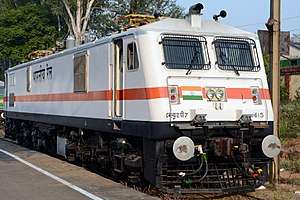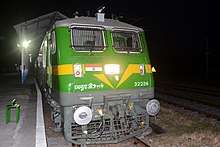Chittaranjan Locomotive Works
Chittaranjan Locomotive Works is a Government electric locomotive manufacturer based in India. It is located at Chittaranjan in Asansol Sadar subdivision with an ancillary unit in Dankuni. It is the largest locomotive production unit in the world with a record of 431 locomotives produced in the year 2019-20 .[1] Almost all electric locomotives running on Indian Railways are manufactured at CLW.
| GOVERNMENT | |
| Industry | Electric locomotive |
| Founded | January 26, 1950 |
| Founder | Indian Railways |
| Headquarters | Chittaranjan, Asansol, West Bengal, India |
| Products | WAP-7 WAP-5 WAG-9 WAG-7 WAP-4 WAG-5 |
| Parent | Indian Railways |
| Website | www |



Introduction
“Rolling Stock’', is obviously the most essential requirement of a railway system. Though the railway system was introduced in India over hundred years ago, no systematic and large scale efforts were made to establish indigenous industry for meeting in full these basic requirements of Railways. The Indian Railways have, therefore, all along been dependent on imports for meeting their requirements of coaches, wagons locomotives and their components. A small beginning was no doubt made in the direction of locomotive manufacture in the East Indian Railway Workshop at Jamalpurm 1885 and in the Bombay, Baroda and Central India Railway Workshop at Ajmer in 1896. The manufacture of locomotives in these workshops was, however, of a sporadic nature and it only formed a side activity of these two workshops, which were primarily repair workshops. [2]
It was not unnatural, therefore, that Indian public opinion should have continuously demanded that arrangements be made for the manufacture of locomotives required for India’s needs in the country. The agitation became particularly strong after the First World War, when import of new locomotives became difficult and existing locomotives had either completely broken down through wear and tear involved during the war or were in a dismal state of disrepair. In the Legislative Assembly during the twenties of the present century, there was a furore of agitation by Indian leaders of all shades of opinion. No effective steps were, however, taken by the Railway authorities to enlarge the scope of locomotive manufacture at Jamalpur and Ajmer. Various practical difficulties were pointed out and reasons plausible and otherwise were advanced in favour of continuing the existing practice of importing locomotives from Britain. The conclusion could not be easily escaped that in this matter, as in many others, those in charge of the Railways at the time, were more interested in the welfare and prosperity of British industries, and preferred to extend the patronage of Indian Railways to British locomotive factories, rather than taking steps towards developing this industry in India. [3]
Srinivasan Committee
Finally in July, 1939 a committee was appointed consisting of a Mechanical Engineer and Finance Officer, Mr. J. Humpherey and Mr. K. C. Srinivasan respectively to examine in detail the scheme of starting the manufacture of locomotives in some of the existing workshops in India and to report on the initial cost and financial implications of such a venture. The Committee, however, recommended that the manufacture of locomotives, despite the war and even because of it, should be taken up at once. steps were taken to implement the recommendations oif the Committee. During the war, the shortage of locomotives became more and more apparent. This only served to emphasise the urgency and the imperative necessity for India to become independent and self-sufficient in respect of locomotives and other equipment necessary for railway operation. [4]
It was not till 1945 that any serious consideration was even to the recommendations of the Srinivasan Committee. A provisional site at Chandmari in the then imdivided Bengal was selected. Not much progress could be made at this site, bec&use of political changes leading to the partition of India. In 1947, the present site, where the Chittaranjan is located, was finally chosen”.
Location of the Project
Selection of site
Chittaranjan is ideally located for an industrial undertaking of this nature. It is situated within 10 miles of West Bengal’s rich coal belt and only 6 miles from the Maithan Dam of the Damodar Valley Corporation from where Hydro-Electric energy will be obtained. The Maithon reservoir will also provide a source of perennial water supply for the township and the workshop. The hilly nature of the country facilitates easy drainage, so important for the establishment of a clean, healthy township and the excellent climatic conditions are expected to ensure a high level of labour attendance and efficiency. Workshop and the colony are spread over an area of over 7 square miles.[5]
Township
Chittaranjan has 5,070 residential quarters, 71 miles of road, 120 miles of piping for water supply and 100 miles of water borne sewage. Every single house has a minimum of two rooms, verandah and courtyai-d, electricity, continuous supply of filtered water, its own sanitary pi’ivy and batii. E ach house in Chittaranjan has been provided with the basic facilities of a modem home. The township has been planned in separate colonies of composite self-sufficient units, each of which has its shopping centre, maternity clinic, school, playground, dispensary, park, social amenity and recreation centres. There are at present in Chittaranjen 5 dispensaries, 4 maternity and health centres. 7 basic schools, 4 community halls and 6 parks. The main hospital has 50 beds and is centrally situated to provide medical facilities for all residents of the township. Two high schools, one for boys and the other for girls, provide secondary education to the young inhabitants. [6]
Water supply
The principal source of water supply at present is the AjaiRiver, a slender hill stream, wlilch passes around the township. As the river gets dried up during the three dry months of April, May and June, an artificial lake with a capacity of 360,000,000 gallons has been built by constructing a 1,600 ft. long and 40 ft. high dam across one of the main out-fall streams to tide over the summer months. At present, a sub-merged dam across the Ajai leads water through a sealed channel into an intake well and thence to the filter beds in the centre of the township with a capacity of 2 million gallons per day. [7]
Power Supply
Electricity was first generated by a number of small portable plants. Subsequently, when the three 600 kW thermal standby sets were ready, energy was obtained from these, and in December, 1950, when the D.V.C. temporary packet sets at Kamardhubi were brought in, power was obtained from there at 11 kV 3-phase, 50-cycle A.C. Since January, 1952, power is being supplied from Sindri at 33 kV over D.V.C. grid. The Committee imderstand that of the three 600 K.W. thermal standby sets, one has been released to the N.E. Railway, Gorakhpur, and until the D.V.C. supply is guaranteed, it is not proposed to release the balance
Overview
Founded in 1950, the Indian Railway production unit is named after the Indian freedom-fighter Chittaranjan Das. The manufacturing unit was established at a place close to the Chittaranjan railway station.
The 18.34 km2 (4,530 acres) township, which included the factory, 191 km (119 mi) of roadways, 43 schools, 9131 staff quarters, 8 clinics (including a 190-bed hospital) and 7 markets, was built at a cost of ₹140 million (US$2.0 million) and had a population of over 80,000.
The factory commenced the production of steam locomotives on 26 January, 1950 (the date when India formally declared itself a Republic), in collaboration with the North British Locomotive Company. On 1 November, 1950, Indian President Dr. Rajendra Prasad formally dedicated the first steam rail-engine produced by the company (a WG class locomotive bearing the registration number 8401) to the freedom fighter Deshbandhu Chittranjan Das. The name of the nearby railway station Mihijam was also changed to Chittaranjan. Many of the specialized machinery required for steam locomotive manufacture was obtained from the Vulcan Foundry in England, previously a major supplier of locomotives to India, which at this time was moving from building steam locomotives to diesel.[8]
In the post-1968s, the factory began to manufacture diesel-hydraulic locomotives. The production of steam and diesel locomotives were discontinued in 1972 and 1993 respectively. The company has since been manufacturing only electric rail-engines. It is now the only government electric loco producing factory in India.
The factory obtains its iron & steel from different steel plants of SAIL, RINL & MDN, and sometimes from private steel plants like TATA, Jamshespur or JINDAL STEEL etc. and hydel power from PGCIL and DVC (Maithan dam). The township under CLW is bordered by high boundaries and 3 main gates, and guarded by Railway Protection Force, Railway Protection Special Force and the West Bengal police.
History
The planners of the nation with their prudence planned to set up a loco building factory in the eastern part of the country. In the late 1930s, a committee consisting of M/s Humphries and Shrinivasan was constituted to consider the possibility of establishing a locomotive manufacture unit and its economic facilities. The initial project at Chandmari, a place east to Kalyani in the state of West Bengal, could not mature due to partition, which inevitably necessitated a change of site. This present site at Chittaranjan was chosen after a fresh survey and for this the approval of Railway board was obtained in 1947.[9] Chittaranjan Locomotive Works (CLW) started producing locomotives from the year 1950, the same year the township was formally established. The approximate value of the imported parts required for the manufacture of locomotives at the Chittaranjan Locomotive Works is Rs. 1,25,000 per locomotive in the year 1955. [10]
Starting with steam engines, CLW now produces state-of-the-art Electrical engines capable of running at 160 km/h and upgradable up to 200 km/h.
Manufactured Locomotives
| No. | Year | Total | withdrawn | BG Loco Cost | MG Loco Cost |
|---|---|---|---|---|---|
| 1 | 1951-52 | 17 | - | - | |
| 2 | 1952-53 | 33 | 7[11] | 5.35 Lakhs | 3.35 - 3.50 Lakhs [12] |
| 4 | 1953-54 | 64 | - | - | |
| 5 | 1954-55 | 98 | - | - | |
| 6 | 1955-56 | 129 | - | - | |
| 8 | 1956-57 | 156[13] | - | - | |
| 9 | 1957-58 | 135[14] | - | - | |
Products
Locomotives
Current
- WAP-7: 6000 hp, 25 kV AC, Indian Gauge, passenger locomotive, 140 km/h, 3-phase IGBT based technology
- WAP-5: 5450 hp, 25 kV AC, Indian Gauge, passenger locomotive, 160 km/h / 200 km/hr, 3-phase IGBT based technology
- WAG-9H: 6000 hp, 25 kV AC, Indian Gauge, freight locomotive, 100 km/h, 3-phase IGBT based technology
- WAG-9HH: 9000 hp, 25 kV AC, Indian Gauge, freight locomotive, 100 km/h, 3-phase IGBT based technology
Former
Traction motors
- I 3-phase Traction Motor Type 6FRA6068 and 6FXA 7059: 3-Phase traction motors type 6FRA6068 for WAG-9 and WAP-7 locomotives and 6FXA7059 for WAP-5 locomotive are being manufactured indigenously by CLW since the financial year 1998-99 and 1999-2000 respectively.
- II Hitachi Traction Motor Type HS15250A: Hitachi traction motors are conventional electric locomotives types WAG-7 and WAP-4 which were in production at CLW. The production of Hitachi is now completely stopped.
See also
References
- "Chittaranjan Locomotive Works is now world's biggest locomotive producer". The Statesman. 2019-04-02. Retrieved 2019-09-12.
- https://eparlib.nic.in/bitstream/123456789/58198/1/ec_01_32_1955.pdf page 8
- https://eparlib.nic.in/bitstream/123456789/58198/1/ec_01_32_1955.pdf page 9
- https://eparlib.nic.in/bitstream/123456789/58198/1/ec_01_32_1955.pdf page 10
- https://eparlib.nic.in/bitstream/123456789/58198/1/ec_01_32_1955.pdf
- https://eparlib.nic.in/bitstream/123456789/58198/1/ec_01_32_1955.pdf
- https://eparlib.nic.in/bitstream/123456789/58198/1/ec_01_32_1955.pdf
- Gudgin, D.S.E. (1976). Vulcan Foundry Locomotives 1832–1956. Truro: Bradford Barton. p. 93. ISBN 0-85153-215-2.CS1 maint: ref=harv (link)
- "About Chittaranjan Locomotive Works". Chittaranjan Locomotive Works.
- https://eparlib.nic.in/bitstream/123456789/55867/1/lsd_01_09_30-03-1955.pdf page 27
- https://eparlib.nic.in/bitstream/123456789/55593/1/lsd_01_05_30-11-1953.pdf Page no. 41
- https://eparlib.nic.in/bitstream/123456789/55641/1/lsd_01_06_25-02-1954.pdf
- https://eparlib.nic.in/bitstream/123456789/1566/1/lsd_02_02_12-08-1957.pdf page 30
- https://eparlib.nic.in/bitstream/123456789/1528/1/lsd_02_03_25-11-1957.pdf page 37
External links
- Chittaranjan Locomotive Works (CLW) Company website